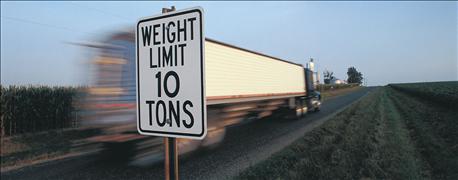
The House and Senate gave themselves more time to work out final details of a long-term transportation bill. The current short-term extension expired on Nov. 20, although the House and Senate each passed another short-term extension until Dec. 4 and the president signed it.
A total of 12 senators and 28 representatives have been delegated to the bicameral conference committee tasked with passing the long-term highway bill.
Conferees from the House and Senate have begun formal negotiations of a long-term surface transportation reauthorization bill. Both chambers have passed their own versions, and a conference committee has been established to work out the differences between the two.

Ag groups have urged Congress to include special provisions in a new highway bill, including a pilot program that allows states to form compacts to allow commercial driver's license drivers ages 18 to 21 to drive across state lines.
In addition to policy differences, the two overarching questions facing negotiators are funding mechanisms and authorization length. Both chambers' bills would authorize the program for six years; some Members of the conference committee have called for shortening the timeframe in order to help address funding challenges.
Ahead of the Nov. 20 deadline, nearly four dozen agricultural organizations urged members of the panel to include in the final legislation among other provisions ones that would: ensure continued operations at the nation's ports through collection of data; provide a permanent exemption for shippers of agricultural products from the U.S. Department of Transportation Hours of Service rule, which requires a 30-minute rest break for each 8 hours of driver service; and establish a pilot program that allows states to form compacts to allow CDL (commercial driver's license) drivers ages 18 to 21 to drive across state lines.
A broad coalition of U.S. businesses and industries also urged urging Congress to have provisions included in the surface transportation reauthorization bill (Highway Bill) to avoid future port disruptions like those that caused a slowdown on the West Coast last winter.
The provisions of the Port Performance Act, included in the final conference agreement of the Highway Bill, would help quantify and measure operating efficiencies of U.S. ports and help to identify key congestion issues that affect the flow of commerce. The American Soybean Association said it signed onto a coalition letter to House and Senate conferees urging them to keep the Port Performance Act provisions in the final bill.
~~~PAGE_BREAK_HERE~~~
As indicated in the letter, the need for the Port Performance Act, and the data it will collect, was evident during the slowdown at West Coast Ports last winter. The disruption at these ports resulted in farmers, retailers and manufacturers being unable to get exports through ports to foreign customers and imports to stores and supply chains. By one estimate, retailers suffered economic damages totaling more than $7 billion during the disruption. The crisis demonstrated that little data is currently being aggregated on port performance and congestion.
As trade continues to grow, these issues could worsen and the Port Performance Act is intended to identify problem areas sooner, so that attention and actions can be directed accordingly.
In addition to the Port Performance Act, separate legislation was also recently introduced in the U.S. House of Representatives to initiate federal action to head off disruptive port slowdowns. The bill is sponsored by Rep. Dan Newhouse, R-Wash., and Rep. Kurt Schrader, D-Ore., and is titled, the Ensuring Continued Operations and No Other Major Incidents, Closures, or Slowdowns (ECONOMICS) Act. Specifically, it would put in place triggers, so when certain economic impacts surrounding a dispute occur, a Board of Inquiry must be convened, and the board is required to report to the president and the public to recommend whether there should be a judicial injunction. These triggers include:
• Number of Ports: When a labor dispute occurs at four or more port facilities.
• Number of Employees: When the number of affected employees at ports totals 6,000 or more.
• Drop in Export or Import Vessel Value: When in one month U.S. imports/exports drop 20% or more.
The ECONOMICS Act also widens the definition of "strike" throughout U.S. labor law to clarify that the president has broad authority to intervene in a variety of disruptions – including slowdowns, strikes, lock-outs, or threatened strikes or lock-outs.
This change in definition will also apply to economic impact triggers. The measure directs the Bureau of Transportation Statistics to develop "Additional Conditions" for appointing a Board of Inquiry within two years of enactment and report appropriate conditions numbers to Congress.
The ECONOMICS Act would require an objective standard that defines when a dispute has reached a level of economic impact to require an Administrative inquiry and possible intervention. Currently, this threshold can be difficult to determine or agree upon.
About the Author(s)
You May Also Like






